We get many questions throughout the year regarding control of stickers in the home lawn. First, determine what type of stickers you are dealing with- Bur Clover, Field Sandbur, Lawn Burweed, Khaki Weed or the very painful Goat Head. Control for each type of sticker bur relates to the time of the year that the seed germinates and whether it is an annual or a perennial weed. Annual weeds are generally easy to control using pre-emergent at the correct time of year, as the plants themselves do not survive from year to year. Perennial weeds require correct timing of pre-emergent as well as a well-timed post-emergent, as the roots live from year to year.
DO NOT APPLY POST-EMERGENT HERBICIDE WHEN LAWNS ARE EMERGING IN THE SPRING OR UNDER THE CANOPY OF ANY TREES. EVER!!!!!!
APPLY WHEN WINDS ARE CALM TO AVOID DRIFT TO DESIRABLE PLANT SPECIES.
PRE-EMERGENTS ARE GENERALLY SAFE TO APPLY UNDER TREES, BUT DO NOT USE UNDER FRUIT OR NUT TREES. ALWAYS READ THE LABEL TO SEE WHAT IS SAFE.
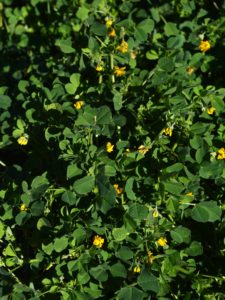 Bur Clover (Medicago sp.) is an annual weed that has a similar appearance to the white clover plant. The plant has round stems and three leaflets which are oval or egg-shape. The flowers of bur clover are numerous and yellow in color. Because it is a cool-season plant, the seeds will germinate in the fall into the winter. Application of a pre-emergent herbicide such as Fertilome Broadleaf Weed Preventer with Gallery or Corn Gluten Meal in mid-September and again in November will work well in controlling this prolific weed. Controlling this weed after it has emerged from the seed is best done when these winter clovers are young and actively growing. Do not wait until late winter when these annual broadleaf weeds are flowering and mature, as the herbicide will not work very well. Multiple applications of a post-emergent herbicide such as Fertilome Weed Out for Lawns may be necessary to control this weed. As always, read the label to determine if a product is safe to use on your lawn type, and do not apply post-emergent herbicide under the drip line of trees.
Bur Clover (Medicago sp.) is an annual weed that has a similar appearance to the white clover plant. The plant has round stems and three leaflets which are oval or egg-shape. The flowers of bur clover are numerous and yellow in color. Because it is a cool-season plant, the seeds will germinate in the fall into the winter. Application of a pre-emergent herbicide such as Fertilome Broadleaf Weed Preventer with Gallery or Corn Gluten Meal in mid-September and again in November will work well in controlling this prolific weed. Controlling this weed after it has emerged from the seed is best done when these winter clovers are young and actively growing. Do not wait until late winter when these annual broadleaf weeds are flowering and mature, as the herbicide will not work very well. Multiple applications of a post-emergent herbicide such as Fertilome Weed Out for Lawns may be necessary to control this weed. As always, read the label to determine if a product is safe to use on your lawn type, and do not apply post-emergent herbicide under the drip line of trees.
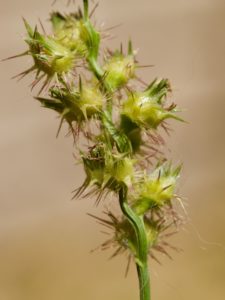 Field Sandburs, or grass burs, are generally not a problem in a well-maintained lawn. With proper fertilization, mowing and irrigation, you can produce a lawn that is dense enough to prevent sandbur from becoming a problem. However, if sandburs do become a problem, timely applications of pre-emergent herbicides do a good job of controlling them. Field sandburs (Cenchrus echinatus), unlike the bur clover, is a warm season weed. It is best controlled by application of a pre-emergent herbicide such as Pendulum 2G, Fertilome Pre-emergent with Dimension or Corn Gluten Meal, beginning in mid-February in Central Texas, with two applications six weeks apart for light infestations, or with applications continuing every six weeks through September for heavily infested areas. As always, the pre-emergent herbicide needs to be watered in thoroughly with about ½” of water. Post-emergent control of sandbur may be accomplished by several applications of a post-emergent herbicide called Image. This product does a better job of controlling field sandbur when it is young than when it is mature. Always check the label for more specific instructions.
Field Sandburs, or grass burs, are generally not a problem in a well-maintained lawn. With proper fertilization, mowing and irrigation, you can produce a lawn that is dense enough to prevent sandbur from becoming a problem. However, if sandburs do become a problem, timely applications of pre-emergent herbicides do a good job of controlling them. Field sandburs (Cenchrus echinatus), unlike the bur clover, is a warm season weed. It is best controlled by application of a pre-emergent herbicide such as Pendulum 2G, Fertilome Pre-emergent with Dimension or Corn Gluten Meal, beginning in mid-February in Central Texas, with two applications six weeks apart for light infestations, or with applications continuing every six weeks through September for heavily infested areas. As always, the pre-emergent herbicide needs to be watered in thoroughly with about ½” of water. Post-emergent control of sandbur may be accomplished by several applications of a post-emergent herbicide called Image. This product does a better job of controlling field sandbur when it is young than when it is mature. Always check the label for more specific instructions.
Lawn Burweed is a cool-season annual weed and germinates when temperatures remain at 55°-60°F a few nights in a row. Apply pre-emergent in September with the active ingredient Isoxyben (Fertilome Broadleaf Weed Preventer with Gallery) and water it in to activate. Post-emergent control for the seeds that germinated should take place in the winter using a three-way herbicide such as Dicamba, Mecoprop, and 2,4-D (Fertilome Weed Out for Lawns). Do not apply a selective post-emergent herbicide under the dripline of trees.
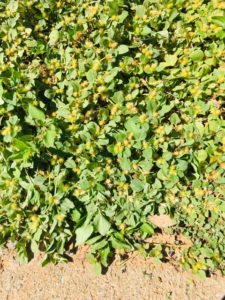
Khaki Weed is a tropical perennial weed with a strong taproot. It is a warm-season weed and germination is controlled in the spring with the active ingredient Isoxyben (Fertilome Broadleaf Weed Preventer with Gallery). Post emergent control with a three-way herbicide (Fertilome Weed Out for Lawns) or repeated applications of glyphosate with a spreader-sticker is necessary. It is a difficult weed to control and will require persistence. Do not apply post-emergent herbicide under the dripline of trees. Always read the label for use on your type lawn.
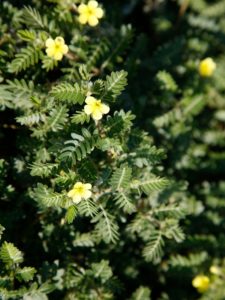

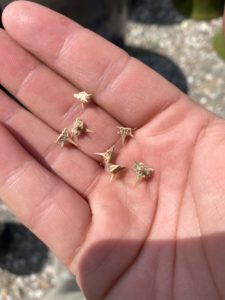
Goat Heads/Puncture Vine (Tribulus terrestris) is the worst of the worst! These sharp dudes can puncture a bicycle tire! Luckily they are annual weeds, and are fairly well controlled by applying a pre-emergent containing Gallery (Isoxyben) in February and again in May. If you wish to control the plants that have already germinated, try to catch them when they are young. A broadleaf weed killer containing 2,4-D will kill them, but it might take a couple of weeks for them to die. DO NOT APPLY POST EMERGENT BROAD LEAF WEED KILLERS TO LAWNS THAT ARE NEWLY EMERGING OR TO ANY AREA UNDER THE CANOPY OF TREES!
You now have guidelines to go by to eradicate those nasty stickers from your lawn!
The preventative approach for Bur Clover and Lawn Burweed is fall, and for Field Sandbur, Goat Heads and Khaki Weed is spring.
Khaki Weed is a perennial and will require both pre- and post-emergent control. And persistence.

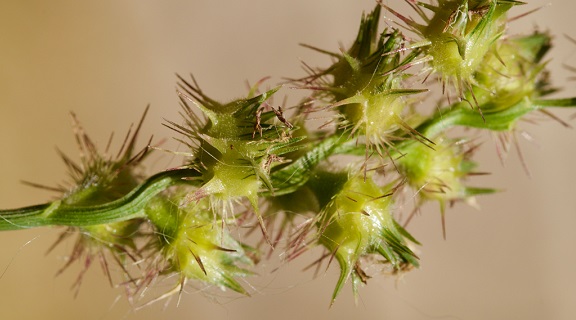
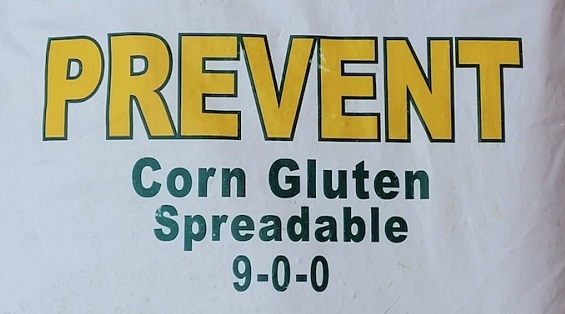
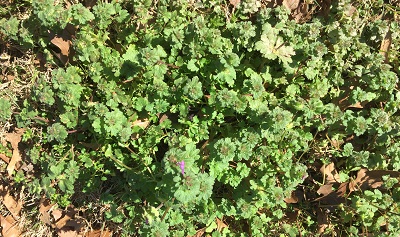
To my uneducated eye, these all look the same . I desperately wish to rid my yard of these painful burrs. May i bring a sample into the nursery for assistance identifying what I have? I am assume you sell all the recommended solutions?
Please take a few good photos of the plant and the burs so that you remember what they are when it is time to control them. You are welcome to bring samples to the nursery for identification as well, but I have found that the photos help when it is time to apply the pre-emergent, as my memory usually fails me! Please note that timing is everything in regards to applying either pre- or post- emergent herbicides. Proper identification will give you the correct timing.